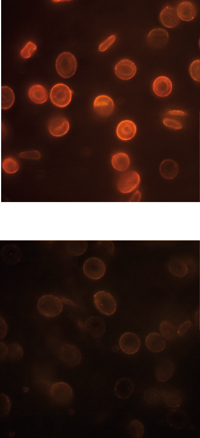Old versus new – red blood cells
5 Jul 2011 by Evoluted New Media

Blood stored for transfusions can undergo significant changes and damage say researchers in Cambridge who have developed a technique to cheaply and rapidly monitor the quality of blood supplies
Blood stored for transfusions can undergo significant changes and damage say researchers in Cambridge who have developed a technique to cheaply and rapidly monitor the quality of blood supplies
|
New red blood cells (top) fluoresce brighter than older ones (bottom) |
Even with preservative, blood stored in blood banks continue to age, resulting in biomaterials leaking from the red blood cells and changes to the cell properties and functions. Using the unique electrical properties of red blood cells, Dr Jay Mehrishi from the University of Cambridge and Professor Yao-Xiong Huang from Ji Nan University in China have highlighted how red blood cells deteriorate in storage.
“This study is the culmination of decades of research into blood cells,” said Mehrishi. “I am thrilled that for the first time visual imaging has provided evidence for the quality of the red blood cells.”
They used fluorescence from positively charged quantum dots – which had been bound to electrical charges on the negatively charged cells – to discriminate between old cells, which had diminished in quality, and younger cells.
Young cells fluoresce intensely, indicating the surface architecture was still intact, but there was almost no fluorescence from older cells, indicating a substantial loss in electrical charges and that cells membrane intensity have been compromised. The body would quickly eliminate cells like this from their circulation as they would not be useful.
“These results are not only of theoretical interest but are also of immense practical clinical value, with vast commercial potential for new, rapid automated monitoring tests in clinics and blood banks worldwide,” said Mehrishi.
Mehrishi says the novel approach is also likely to be of practical value in clinics before, during and after therapy, for problems like circulatory disorders, abnormal red blood cells, microphages, hypoxia and those at high altitude.


